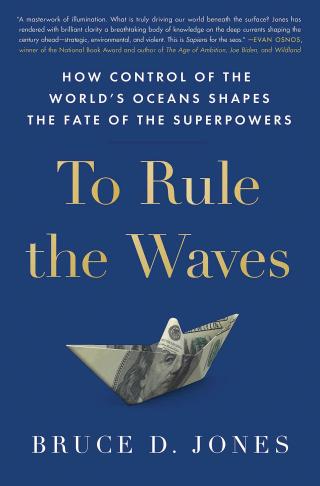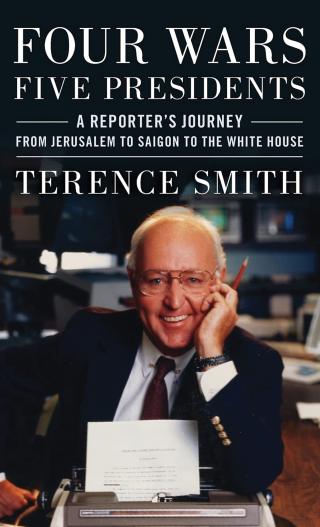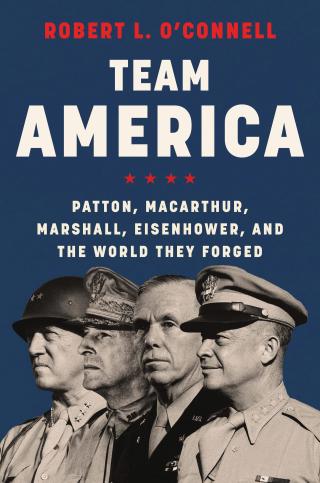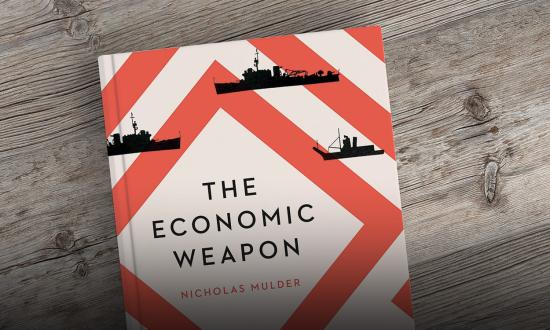To Rule the Waves: How Control of the World’s Oceans Shapes the Fate of the Superpowers
Bruce D. Jones. New York: Scribner, 2021. 389 pp. Photos. Notes. Index. $28.
Reviewed by Captain Sam J. Tangredi, U.S. Navy (Retired)
The most recent triservice strategy document of the U.S. Navy, Marine Corps, and Coast Guard, Advantage at Sea, begins with the statement, “The United States is a maritime nation.” But do most Americans actually believe that?
In To Rule the Waves, Bruce Jones sets out to prove it to them. He attempts to demonstrate how U.S. prosperity and the nation’s future are tied to access to the seas, which is being challenged by those—such as the People’s Republic of China—who want to carve it up. Jones approaches the subject with history, reporting, and travelogue, similar in concept to the books of Thomas Friedman and Robert D. Kaplan.
Jones describes his voyage (as he terms it) to key global ports such as Singapore, Hong Kong, and Elizabeth, New Jersey, observing maritime operations and profiling individuals involved, including a merchant ship captain, a shipping company founder, and a U.S. Coast Guard port captain. His section on the role of navies is anchored by details gathered during his time on board the USS John Paul Jones (DDG-53), and he profiles the ship’s commanding officer as well. It is unfortunate that he did not spend more time describing the lives and careers of enlisted sailors—many who came from towns far from the ocean. However, that appears to be oversight rather than deliberate choice.
Jones discusses key modern naval missions and concepts—such as theater ballistic missile defense, antiaccess/area denial, and interoperability with allies—as well as the overall challenge of the People’s Liberation Army Navy and China’s determination to decouple the United States from Asia. Although not an explicit recommendation, Jones hints that a global blockade of Chinese shipping at key choke points might be the best strategy in a confrontation.
Jones is an academic and fellow of the Brookings Institution. Throughout his travels and observations, he weaves in stories of how the maritime world has determined much of global history, how ocean exploration developed, and how apparently non-maritime activities depend on ocean transport in largely unrecognized ways. For example, he points to the fact that major airports (not usually associated with maritime activities) often are collocated with ports, since jet fuel is most cheaply transported over water. However, effects may not always seem positive. One of his more provocative conclusions is that the United States would not have lost so many manufacturing jobs if it were not for the container ship and the ease in which goods assembled in low-wage countries can cross oceans.
To Rule the Seas has been chosen for the Chief of Naval Operations, recommended reading list, which was recently slimmed to about a dozen books. The book has much for a naval person to love, and is currently the best in its category. I learned some interesting details, such as that the ocean territory claimed by China in the South China Sea is sometimes referred to as the “cow’s tongue.” Its outline does indeed look like that on the map/chart.
However, To Rule the Waves will not teach the average Proceedings reader much he or she does not already know, and clearly the intended audience is those pondering whether the United States is a maritime nation. Nevertheless, it is a book that Proceedings readers should buy and give to friends if they want them to understand the effect of the oceans on their future.
In summary, To Rule the Waves describes how U.S. prosperity and freedom are intertwined with the sea in a way that just cannot be stuffed into a strategy document.
Captain Tangredi holds the Leidos Chair of Future Warfare Studies at the U.S. Naval War College. In addition to being a frequent contributor to Proceedings, he has published seven books and has participated in the writing of many strategy documents.
FOUR WARS, FIVE PRESIDENTS: A Reporter’s Journey from Jerusalem to Saigon to the White House
Terence Smith. Lanham, MD: Rowman & Littlefield, 2021. Index. $32.
Reviewed by A. Denis Clift
A foreign correspondent in time of war is often at the conflict’s front—occasionally dodging fire—gathering and reporting the news, whether embarked on a Navy ship, embedded forward with ground troops, or racing through city alleys. In Four Wars, Five Presidents: From Jerusalem to Saigon to the White House, Terence Smith presents his war correspondent’s saga.
Smith, the son of Pulitzer Prize–winning sports reporter Red Smith, grew up wanting to report. He quotes his father’s philosophy of the news trade, “Writing is easy, just sit down, open a vein, and bleed.”
From 1958 until 2005, Terence was working and climbing in the trade, first with the Stamford Advocate, then the New York Times, CBS News, and PBS NewsHour. He was putting in long hours, first typing his reports on a manual typewriter and filing his stories by telephone and cable in the heydays of print journalism, joined by television networks—long before today’s ever-evolving era of near-instant, nonstop digital news.
Young and newly posted to Jerusalem by the Times in June 1967, Smith immediately found himself covering the Six-Day War. From Israel, his next assignment was as the Times Southeast Asia correspondent in Bangkok in the late 60s, with the widening Vietnam conflict on his doorstep. From there he became the paper’s bureau chief in Saigon, heading out by chopper into battles. Next, he was back to Israel for the October 1973 war; then went over to Cyprus for the 1974 Greek Cypriot–Turkish conflict.
Smith is a gifted storyteller and raconteur. For those in uniform today, dealing with the media and faced with a 24-hour news cycle, his book educates professionally and, at the same time, is good reading.
Mr. Clift is the vice president for planning and operations at the U.S. Naval Institute.
Spies, Lies, and Algorithms: The History and Future of American Intelligence
Amy B. Zegart. Princeton, NJ: Princeton University Press, 2022. 280 pages. Tables. Figs. Notes. Index. $29.95.
Reviewed by Captain Joshua Himes, U.S. Navy
Author Amy Zegart delivers an engaging and wide-ranging perspective on the intelligence community (IC) in her work, aptly subtitled, The History and Future of American Intelligence. While downplaying her bona fides in the IC, likening herself to an “anthropologist” who observes from afar, her background as a Stanford professor and the director of Stanford’s National Security Affairs Fellows program and her support to multiple Presidential administrations in the national security and intelligence fields provide an impressive resume from which to observe and enlighten. This book is just as easily used in a classroom setting as it is on the nightstand of the casual reader.
Zegart’s ambitious effort captures decades of research as well as interviews that map the trajectory of IC operations, policies, and challenges. She begins appropriately by examining shortfalls in education on the intelligence field, then continues with a fascinating review of American espionage efforts since the Revolutionary War. She closes the history chapter with the longstanding dilemma that will weave throughout the book—how to effectively balance security with liberty. It is from this foundation that she opens the aperture to look across the intelligence discipline with an eye to future challenges.
The following chapters dive into fundamentals of the intelligence field and profession, with multiple engaging vignettes that bring her concepts and arguments to life. Intelligence basics, the challenge of analysis, counterintelligence, and covert action form the core of the book. While each chapter has riveting vignettes juxtaposed with academic rigor, I particularly appreciated Zegart’s review of the cognitive traps that challenge analytic success, and how digital age alternatives—artificial intelligence in particular—may or may not mitigate some of that risk. She also provides a balanced portrayal of the blurring of mission lines following 9/11. Her description of the integration of intelligence and Department of Defense warfighting hit the mark and effectively characterized the opportunity cost of prioritizing covert action potentially at the expense of more traditional intelligence missions designed for understanding and warning.
The subsequent chapter on congressional oversight was a welcome addition—exploring a critical relationship with the IC that is not often appreciated or understood. Zegart’s efforts to break down the history of oversight, as well as the existing challenges of effective oversight going forward, are a must read for anyone interested in national security seams and vulnerabilities for the IC in the future.
The final chapters turn to a valuable case study on “nuclear sleuthing,” which details how technology is changing the nature of the intelligence game, and the implications of the rise of cyber threats to the intelligence community value proposition. The level of detail in both chapters describing how current technology trends are fundamentally shifting the playing field and blurring lines among governments, civilians, and commercial actors was excellent.
While Zegart’s objective is to give readers a full understanding of intelligence, she also paints a compelling picture of the challenges ahead, particularly as they relate to emerging technologies. Zegart brings together what has been an underlying theme throughout the book: The digital age is changing the rules and therefore driving new approaches to the intelligence business that the U.S. IC must adopt if it is to be successful going forward. In particular, her use of nuclear proliferation and cyber threat vignettes to show how technology and information disruption have driven a paradigm shift of unprecedented scale and speed provides a compelling sense of urgency for those shaping IC missions and driving intelligence community operations.
Zegart’s message is clear—U.S. agencies and overseers must adapt accordingly, or they are destined to fail.
Captain Himes is a career naval intelligence officer. He is currently serving as the Chief of Staff for the U.S. Navy Fleet Cyber Command.
Team America: Patton, MacArthur, Marshall, Eisenhower, and the World They Forged
Robert L. O’Connell. New York: HarperCollins, 2022. 576 pp. Notes. Index. $29.99.
Reviewed by Lieutenant Commander Michael Axel, U.S. Navy
At the risk of giving away the ending, “the world they forged” seems to be less about the triumphs of World Wars I and II and more about what happened after the wars were over, which was unexpected given the instant name recognition of the subjects.
Robert O’Connell’s four-for-the-price-of-one collective biography about the Army’s four world war generals is as much about the state of affairs left behind as a result of their actions in war as it is about the actions themselves. By interweaving the lives and military careers of George Patton, Douglas MacArthur, George Marshall, and Dwight Eisenhower, O’Connell shares the often-told stories of World Wars I and II through the eyes of the men who led the U.S. military during and after the wars.
He follows the lives and careers of these four men through the beginning stages of warfare’s evolution into today’s mechanized and nuclear-armed battlespace. Patton, the consummate warrior, directly oversaw the shift away from cavalry toward mechanized warfare, but in the end found that his preferred style of warfare had been rendered largely obsolete by technological progress. MacArthur, ambitious and confident, succeeded in winning the western Pacific and overseeing the rehabilitation of a new Japan, before ultimately also falling prey to both the changing face of war and his own ambitions. Marshall, the quintessential strategist, managed the massive mobilizations of both the Army and the U.S. economic engine, to defeat and then rebuild continental Europe under the plan that bore his name. Finally, Eisenhower, a calculating politician both in and out of uniform, came to embody the transition into the nuclear age, first as Supreme Allied Commander for Overlord, arguably the climax of prenuclear warfare, and then as the face of U.S. nuclear brinkmanship in the infancy of the Cold War. These four intertwined stories chart more than a half-century of U.S. military and economic accomplishment, as experienced by and around the men who led the efforts.
O’Connell is an engaging writer, and the book reads as if dictated in a lecture hall. It is no small challenge to keep readers invested when recounting four stories that only occasionally intersect, but he manages it without overwhelming or boring readers with overlong tactical recaps or irrelevant asides. The overarching metaphor of a sports season keeps the narrative tight and predictable. Covering more than 80 years and four lifespans is accomplished with only a few truly forgettable segments. This includes the final chapter, which would be better delivered as an epilogue rather than as part of the main body, where O’Connell’s editorializing would have been warranted and appropriate.
The casual tone makes for relatively effortless reading, much easier to take in than the dense histories and eye-watering strategy treatises of War College nightmares. The retellings of major military operations in both world wars and Korea presume a knowledge of the facts of relevant battles, which at times required some quick cross-referencing to catch back up. These segments are balanced well by the conversations between the generals and the countless individuals who came and went in their lives, as well as the surprisingly few direct interactions among themselves. Taken together, the interplay between action and exposition keeps the book well-paced and also keeps the focus on the generals as both leaders and as men, as they became leaders of the military, industry, and government.
It also is a perfectly timed release, arriving during a moment of increased concern about nuclear arms and the return of overt strategic deterrence. The world’s first steps into the nuclear age were helmed by people who had led, to that point, the most destructive conflicts in history, and even they were caught unprepared by the consequences of nuclear war. As the world order born in no small part by these four Americans shows possible signs of destabilizing, O’Connell offers a look into the circumstances that led to their respective ascensions to power. The lessons from the 20th century’s conflicts continue to show themselves applicable to today’s geopolitical challenges, and revisiting them from the point of view of those who led the way seems a timely reminder about the many advances made in both the science and art of warfare, as well as their grave consequences.
Lieutenant Commander Axel is a naval flight officer. He is currently serving as an air warfare officer at the Naval Surface and Mine Warfighting Development Center.










